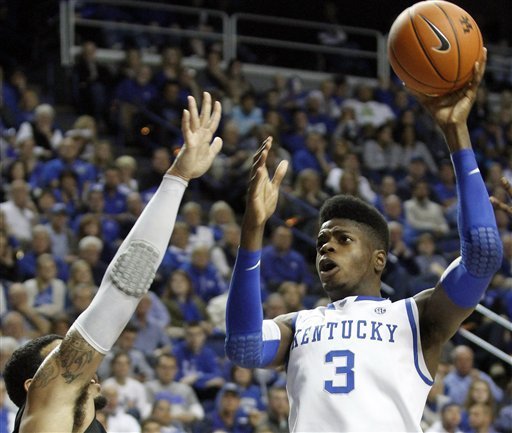Kentucky’s Success Rides on Defensive Rebounding
Posted by DPerry on November 24th, 2012Doug Perry is an RTC correspondent and SEC microsite writer. He filed this report from Friday night’s Kentucky-LIU-Brooklyn game in Lexington. Follow him on Twitter for more about SEC basketball @DougFPerry.
Kentucky went in to Friday night’s game against LIU-Brooklyn hoping to quickly erase its poor Morehead State showing from the memory of the Rupp Arena faithful. The opening minutes didn’t go as planned for the Wildcats, though, as they faced a 43-40 deficit heading in to the first half’s final media timeout. The Blackbirds consistently beat the Wildcats down the floor after giving up buckets, resulting in countless open looks. In fact, Kentucky could have easily been in even worse shape if not for their superb shooting performance (23-33 for the half). Their weren’t any boos from the fans, but the crowd of over 22,000 was noticeably restless. Fortunately, for the collective sanity of the Big Blue Nation, the Wildcats were a different team after the timeout, ending the half on a 15-0 run before pulling away further in the second half for a 104-75 victory. Archie Goodwin was the star, filling up the box score to the tune of 22 points, nine rebounds, and nine assists. Fellow freshmen Alex Poythress and Nerlens Noel added 22 and 18 points, respectively.

Kentucky’s frontcourt was superb against LIU-Brooklyn, but questions about their rebounding linger. (Centre Daily Times)
Kentucky’s impressive final 24 minutes is a welcome sign for a team facing two tough opponents in Notre Dame and Baylor over the next week. However, there is one especially pressing concern that a resounding win over an overmatched opponent from the NEC can’t suppress: defensive rebounding. The Wildcats rank 226th in the nation with a defensive rebounding rate of 66.5%, a shocking figure for a team that boasts three rotation players standing 6’10” or taller. John Calipari’s teams in Lexington haven’t been reliant on rebounding for their success, but each of his three previous squads posted respectable rates of over 70%.
Why does a team with such a substantial height advantage give up so many offensive rebounds? “Because they all want to be shot blockers,” Morehead State coach Sean Woods said Wednesday. “That’s what we wanted to exploit.” Exploit they did. The Eagles employed a physical style that enabled them to rack up 13 offensive boards. Even LIU, a much less aggressive opponent, grabbed six in the first half. Kentucky’s defensive rebounding woes aren’t subject to a quick fix. The entire frontcourt can improve. Noel is never short on effort, but his instincts aren’t quite as good as advertised and his lack of strength is exploitable. The same can be said for Willie Cauley-Stein. Kyle Wiltjer doesn’t have the physical tools to be a force on the boards, but he has to improve in that area if he expects to stay on the floor. The Wildcats will endure a trial by fire in their next two games. Notre Dame’s Jack Cooley (6’9”, 246 lbs.) ranks fourth in the nation with an average of five offensive rebounds a game, while Baylor’s Isaiah Austin (7’1”, 220 lbs.) has a frame almost identical to Maryland’s Alex Len, who dominated Kentucky’s front line in the season opener.









































